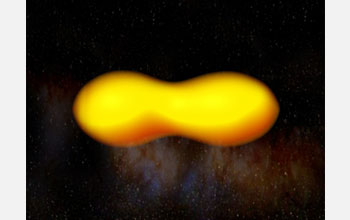All Images


Press Release 08-049
New Star Systems First of Their Kind

Two binary star systems could explode as yellow supergiants
Back to article | Note about images
 |
A newly discovered star system called "a yellow supergiant eclipsing binary" contains two very bright, massive yellow stars. They are orbiting each other so closely, they share stellar material, and the system resembles a peanut. Such systems could be progenitors of unusual yellow supernovas.
Credit: Ohio State University. |
Download the high-resolution JPG version of the image. (153 KB)
|
Use your mouse to right-click (or Ctrl-click on a Mac) the link above and choose the option that will save the file or target to your computer.
|
|


